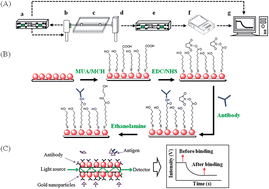The availability of techniques for sensitive detection of early stage osteoarthritis is critical for improving patient health. This study illustrates the feasibility of a fiber-optic particle plasmon resonance (FOPPR) sensor with gold nanoparticles on the unclad region of optical fiber probes for analysis of osteoarthritis biomarkers, tumor necrosis factor-α (TNF-α) and matrix metalloproteinases-3 (MMP-3). Results show that the sensor can achieve a refractive index resolution of 5.18 × 10−7 RIU and limits of detection for TNF-α and MMP-3 as low as 8.22 pg ml−1 (0.48 pM) and 34.3 pg ml−1 (1.56 pM), respectively. Additionally, the FOPPR sensor shows a good correlation in determining TNF-α and MMP-3 in synovial fluid with the clinically accepted enzyme-linked immunosorbent assay (ELISA) method. Finally, given the FOPPR sensor's nature of being low-cost, label-free, highly sensitive, real-time, simple-to-operate, the FOPPR sensor could offer potential to monitor biomarkers of various diseases, and provide an ideal technical tool for point-of-care diagnostics.

You have access to this article
 Please wait while we load your content...
Something went wrong. Try again?
Please wait while we load your content...
Something went wrong. Try again?


 Please wait while we load your content...
Please wait while we load your content...